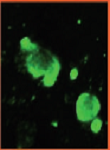|
|
|
Testing CFTR in epithelial organoids for drug development and diagnosis of cystic fibrosi
|
|
|
|
|
|
|
|
|
|

|
|
|
Caldrer S, Vercellone S, Sandri A, Sori C, Rodella L, Cerofolini A, Lombardo F, Catalano F, Bernardoni L, Buffelli M, de Jonge H, Assael B, Melotti P
|
|
|
|
Cystic Fibrosis Translational Research Lab Lissandrini
|
Medicine Dpt., Cystic Fibrosis Translational Research Lab Lissandrini, Univ, Verona; Cystic Fibrosis Center, Azienda spedaliera Universitaria Integrata, Verona, Italy
|
|
info@postdocjournal.com
|
|
|
|
|
|
|
|
|
|

|
|
Background. In vivo and ex vivo measurements of CFTR function in human cells and tissues is required for screening and monitoring new therapies and phenotyping controversial CFTR genotypes. We set up a technique enabling intestinal stem cells to expand into closed organoids containing crypt-like structures and an internal lumen lined by differentiated cells (Sato et al Gastroenterology 2011) for measuring CFTR function. 2011).
Hypothesis and objectives. This quantitative method could be useful to detect the effects of CFTR genetic variants/rare mutations as well as of drugs targeting specific CFTR. The combination with other functional tests could support controversial diagnosis and drug development.
|
|
|
|
|
|
|
|

|
|